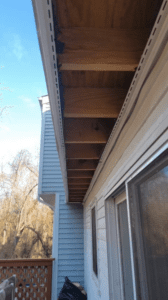
Cold rooms above cantilevers (CROCs) are a common issue in many homes, often leading to discomfort and increased energy bills. These overhanging spaces can suffer from poor insulation and air leakage, resulting in significant heat loss. Addressing this problem is crucial for maintaining a comfortable living environment and improving your home’s energy efficiency. By understanding and fixing the root causes of cold cantilevered rooms, homeowners can enhance their comfort, reduce energy consumption, and save on utility costs.
Cantilevers & Why They Get Cold
A cantilever is a structural element that extends horizontally and is supported at only one end, commonly used in home construction for overhanging rooms, balconies, or other protrusions. While cantilevers add architectural interest and additional space, they are prone to becoming cold due to several factors. Poor insulation installation (needs to touch the sub floor), air leakage (joists should be sealed) , and thermal bridging can cause significant heat loss in these areas. Without proper insulation and sealing, cold air can infiltrate the room, making it uncomfortable and increasing energy consumption as heating systems work harder to maintain a consistent temperature.
Problem Areas & Solutions
Signs of poor insulation in cantilevered rooms include drafts, cold floors, and unusually high energy bills. These symptoms indicate that your home may be losing heat, causing discomfort and increased heating costs. To accurately detect areas with inadequate insulation, you can use infrared cameras, which reveal temperature variations and pinpoint cold spots. Additionally, conducting a home energy audit can provide a comprehensive assessment of your home’s energy efficiency, identifying problem areas and recommending solutions to improve insulation and reduce energy waste.
Air Sealing & Heating Options
Air sealing techniques are crucial for preventing drafts and heat loss in cantilevered rooms. Common areas to seal include gaps around joists, floor edges, and any penetrations for plumbing or electrical work. Using quality sealants, such as caulk or expanding foam, can effectively block cold air infiltration. In addition to sealing, supplemental heating options like radiant floor heating, space heaters, or baseboard heaters can provide extra warmth. These solutions can enhance comfort and efficiency, ensuring that cantilevered rooms remain cozy even in colder weather.
Conclusion
Fixing cold cantilevered rooms is essential for enhancing both comfort and energy efficiency in your home. Proper insulation and sealing of these overhanging spaces can prevent heat loss, reduce drafts, and lower energy bills. By addressing these issues, you create a more comfortable living environment and contribute to overall energy conservation. Taking action to fix cold cantilevered rooms not only improves your immediate comfort but also has long-term benefits for your home’s efficiency and sustainability. Don’t wait—make the necessary improvements today for a warmer, more energy-efficient home.
If you’re ready to schedule a home energy audit and explore your “CROC” solutions, please contact us.
